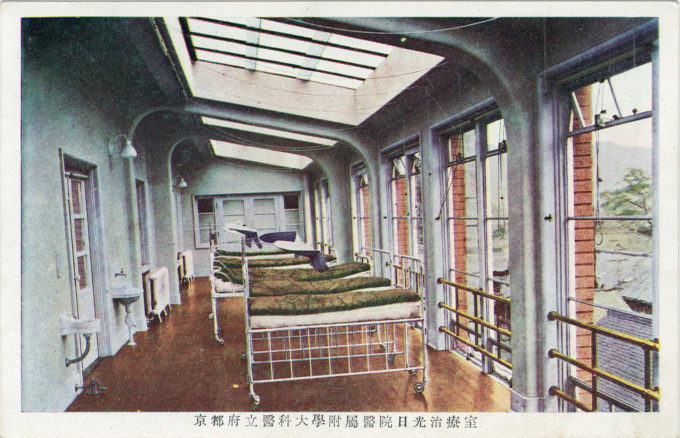
Daylight therapy room, Kyoto Imperial University Hospital, c. 1920. The Kyoto Imperial University College of Medicine established in July 1899, with the university hospital opening in December 1899 (and renamed Kyoto Imperial University Hospital in 1919). Before the invention in the 1940s of medications to control tuberculosis, daylight therapy was used as an effective treatment.
See also:
Ward in the Japanese Red Cross Central Hospital, Tokyo, c. 1910.
Keio University Hospital, Tokyo (Shinanomachi), c. 1920.
St. Luke’s International Hospital, Tsukiji, c. 1945-50.
“The tissues of the human are composed of cells. The body is a city of cells, variously grouped and energized. Light is an essential factor in the birth and growth of these cells. Light influences the free interchange between liquids and solids and the skin surfaces of the body are protected to a degree limited by absorption regulated from energies within the body as well as from without the body … The effectiveness of daylight is in proportion to the protection afforded and to the degree of cell absorption , stimulation , and excitation acquired by the ever surrounding medium.
“In fashioning a daylight therapy, the few above cited observations form the basis of a most wonderful and strangely successful reconstructive application of energy to the disabled human body.
“In the last two decades three forms of light or, more technically, rays, have not only been discovered but are at the present moment the most useful factors in the therapeutic history of the world. They are the Roentgen rays, radium, and daylight. Marvelous as they each are in the class they serve, the last is the most wonderful of all.
“The sun is a great surgeon and a great doctor. The re-discovery of daylight therapy marks a new era in medicine and the thoughtful, progressive physician will gladly devote the necessary time to acquainting himself with this new-old addition to his armamentarium.
“… In 1882 Robert Koch discovered the Bacillus Tuberculosis and observed ‘that the tubercle bacillus was killed by exposure to direct sunlight in a few minutes to several hours according to the thickness of the layer exposed.’ Some laboratories contend that the isolated bacillus is destroyed by exposure to the single ray of light in seven minutes and the spore in twenty minutes.
“This form of destruction differs from the killing by chemical substances – the light rays are credited with destroying the vitality of the bacillus; chemistry destroys the substance.”
– “Daylight Therapy”, by E. Stillman Bailey, M.D., Chicago, The Clinique, April 1919

